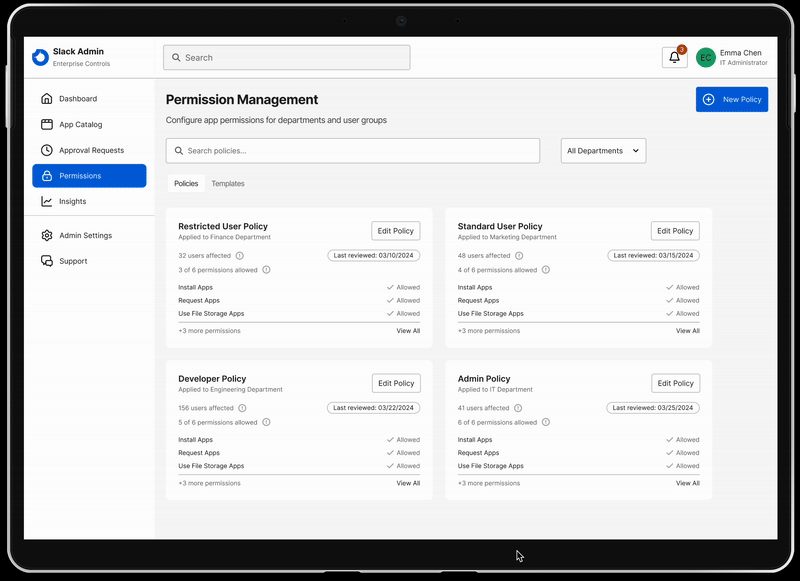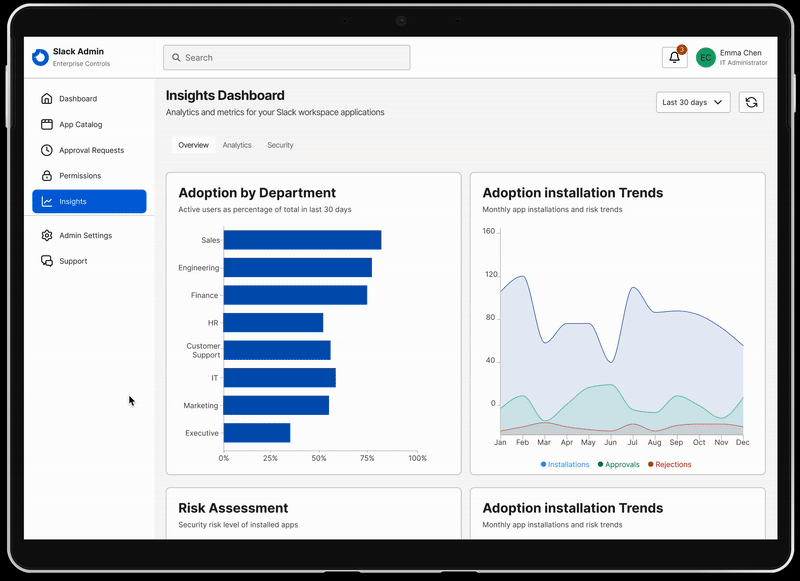Slack Enterprise: Redefining App Governance at Scale
Designing Governance, Control, and Clarity for Slack at Scale
Personal Project | Case Study | Product Design
My Role
Product Design
User Research
Product Thinking
Tools
Figma
G-Suite
Timeline
April - May 2025
Project
Concept project reimagining how enterprise admins manage third-party app integrations within Slack's Enterprise Grid.
Slack is a powerful collaboration platform, but administering third-party app integrations at an enterprise scale becomes a high-stakes balancing act. Admins must manage risk, enforce policy, and enable productivity across thousands of users and apps within complex security and compliance environments.
In Slack Enterprise Grid, governance isn’t just a backend task; it’s a cross-functional challenge involving IT, security, and compliance teams. As organizations grow and decentralize, the need for intuitive, flexible, and scalable tools becomes critical.
As a Product Designer, I led a conceptual design initiative to reimagine Slack’s admin experience for enterprise-scale governance. Grounded in secondary research, platform documentation, and real-world admin pain points, I developed a north-star vision for a more usable, collaborative, and transparent system that empowers admins to govern with clarity and confidence.
Problem
Slack empowers modern teams, but app governance becomes a complex and resource-draining challenge at an enterprise scale. Admins are tasked with overseeing:
Hundreds of third-party apps across thousands of users
Manual, inconsistent approval workflows that slow productivity
Mounting compliance risks and escalating security concerns
Fragmented visibility into app usage, access levels, and permission changes
Complex, brittle rule logic that struggles to adapt to scale or evolving needs
The “Custom Rules for App Requests” interface aims to bring automation to these workflows by letting admins define logic like:
“If the requester is from Marketing and the app requests read-only permissions, auto-approve.”
But while the logic is flexible, the interface is opaque, fragile, and complex to scale. Admins often face a minefield of edge cases, unclear rule outcomes, and manual cleanup. Collaboration across IT, Security, and Compliance only adds friction, as siloed responsibilities compound the risk of misconfiguration and oversight.
Core Challenge
How might we empower Enterprise Grid admins to confidently and securely govern Slack apps at scale and with minimal friction through more intuitive rules, actionable insights, and streamlined workflows?
Custom Rules
How might we streamline the creation and management of app approval rules so admins can enforce policy with confidence and flexibility?
Integration Visibility
How might we provide admins with clear, actionable insights into app usage and risk across workspaces, not just static lists?
Approval Workflow
How might we improve the app request and approval experience so that requesters and approvers share context, urgency, and accountability?
Bulk Management
How might we help admins manage large-scale app lists more efficiently through smart filtering, batch actions, and lifecycle prompts?
Goal
Personalized Insights: Empower admins with data-driven guidance, usage patterns, and rule previews that support confident decision-making.
Flexible Policy Controls: Provide granular, visual rule-building tools that reflect the complexity of real-world governance needs.
Collaborative Workflows: Facilitate alignment between IT, Security, and Compliance through shared context, threaded comments, and clear sign-offs.
Solution
Slack at Scale: Smarter Enterprise App Governance
Design the custom rules interface to make it more intuitive and visual for enterprise admins.
Design the insights dashboard to highlight app usage trends, security risks, and compliance gaps.
Design a new collaborative approval workflow that supports multi-team decision-making and reduces bottlenecks.
Design a new policy templates feature that helps admins quickly apply security and compliance best practices.
Design a new alert and recommendation system to proactively notify admins of risky patterns or rule conflicts.
Design Process
Double Diamond Framework
Using the double-diamond framework, I expanded my research to explore various issues. After this exploration, I honed in to define our specific "How Might We" question and the desired outcomes.
Design Principles
Unified & Contextual – Keep relevant data, controls, and context in one place to minimize switching and empower confident action.
Efficient at Scale – Accelerate routine workflows with reusable patterns, bulk operations, and intelligent filtering that scale as fast as your organization.
Granular & Flexible – Support complex enterprise needs with flexible rule logic and precise policy controls tailored to real-world scenarios.
Proactive & Actionable – Surface meaningful insights, flag risks, and provide clear next steps, enabling admins to act before issues escalate.
Clear & Consistent –Use consistent visual patterns and clear hierarchy to reduce errors, speed up onboarding, and build user trust.
Research
Without access to internal admin tools or proprietary Slack usage data, I adopted a simulation-based research approach to mirror the realities enterprise IT administrators face managing app governance at scale..
Research Objective
My goal was to understand the friction points, mental models, and operational burdens experienced by Slack Enterprise Grid administrators, particularly around app approvals, security risk, visibility, and scalability. I wanted to surface opportunities for a more intuitive, efficient, and confident admin experience.
Methods
I assessed insights from multiple publicly available sources:
Slack’s Enterprise Grid documentation and admin dashboards
Peer benchmarking of admin tools from Microsoft Teams, Okta, and Google Workspace
Analysis of over a dozen support threads across Reddit, Slack forums, and IT community sites focusing on real-world admin frustrations tagged with “Enterprise Grid,” “app approval,” “admin workflow,” and “Slack security.”
Persona-Driven Workflow Simulation
To ground my analysis in a real-world context, I created a persona: Emma Chen, a seasoned Enterprise IT Administrator for a 10,000+ employee organization using Slack Grid.
Emma’s responsibilities include managing app requests, routing them to appropriate reviewers (e.g., Legal and Security), and ensuring that installed apps meet compliance and productivity standards. I mapped Emma’s workflows across multiple admin tasks and then pressure-tested the current tooling through her lens, identifying breakdowns, workarounds, and pain points that informed targeted design interventions.
Synthesis
From this simulation-driven research and persona-guided workflow analysis, I surfaced five core pain points affecting app governance at scale:
Disjointed Approval Chains
App approval often involves fragmented communication, including email threads, DMs, and inconsistent handoffs between IT, Legal, and Security. This leads to delays, confusion, and a lack of auditability.
Limited Visibility into Risk
Admins struggle to assess whether an app’s permission scopes (e.g., “read messages,” “write to files”) align with org policies. There’s little support for identifying risky or evolving scopes over time.
Generic, Unactionable Analytics
Slack’s built-in analytics focus on usage frequency, but admins need insights tied to permission risk, team-specific adoption, and compliance impact to make governance decisions..
Inefficient Management at Scale
As app catalogs grow, navigating and managing hundreds of apps becomes tedious. Limited filters, no tagging, and a lack of batch operations force admins to take a manual, repetitive approach..
All-or-Nothing Install Decisions
Slack’s approval model doesn’t support nuanced usage. Apps are either globally approved or denied, without the ability to scope access by team, data sensitivity, or context of use.
I then worked with simulated workflows, Slack documentation, and competitive analysis to pinpoint specific areas for improvement in a typical enterprise app governance workflow.
I identified five core stages that Slack administrators go through. I mapped out common tasks, recurring pain points, and potential design opportunities for each stage. These insights created a foundation for actionable product strategy.
Solution Highlights
Enabling Slack admins to govern apps confidently through smarter rules, clearer insights, and scalable workflows.
Main Dashboard
App Catalog Dashboard
Approval Request Dashboard
Permission Dashboard
Insights Dashboard
So, what went well?
Strategic Problem Framing:
The project began by articulating enterprise pain points—inefficient app approval workflows, lack of visibility into app usage, and inconsistent governance across workspaces. This ensured alignment with real admin needs from the outset.
Data Visibility Improvements:
New dashboards and usage insights offered admins a high-level view of app proliferation, user engagement, policy compliance, and previously hidden or fragmented features.
That's nice, but what would I do differently if I had more time?
Conduct Real-World Testing with Admin Teams:
While the design was informed by strong assumptions and simulated research, working with actual enterprise Slack admins would uncover nuances around organizational structure, policy enforcement, and user education gaps.Deeper Integration Mapping:
Explore how the redesigned Slack governance features could integrate with tools like Okta, Microsoft Entra, or internal ticketing systems to embed fully into enterprise IT ecosystems.Automated Policy Suggestions:
Prototype features that offer AI-driven recommendations for permissions or rule creation based on app behavior and usage patterns, reducing manual workload for overburdened admins.Accessibility and Theming Support:
Extend the design system to support accessibility standards and enterprise-level theming (e.g., dark mode, custom branding) for consistency across global organizations.Change Management Toolkit:
Create a companion resource kit (e.g., training slides, FAQ templates, and onboarding checklists) to help admins smoothly introduce new governance workflows within their organizations.Mobile Admin Experience:
Explore lightweight mobile-first admin capabilities, such as reviewing or approving requests on the go and supporting hybrid work needs.










